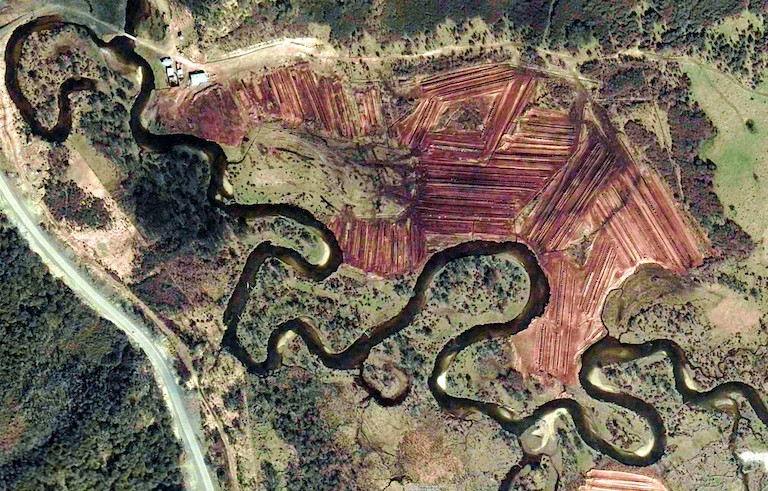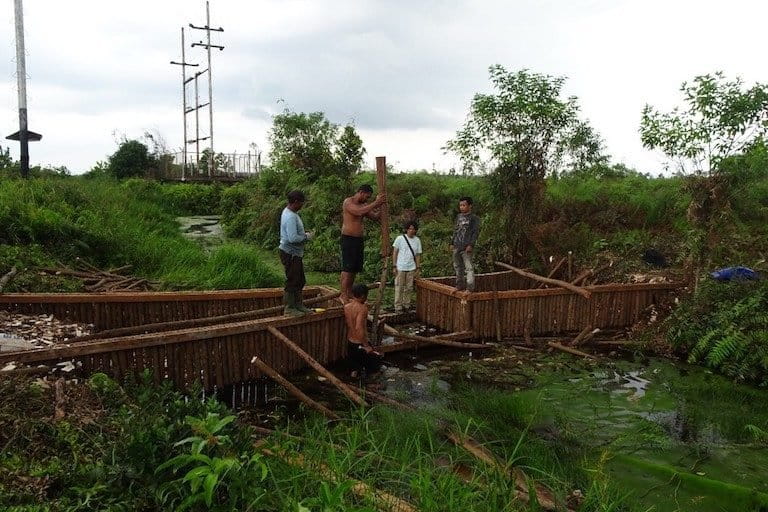‘Cooling the climate for 10,000 years’: How saving wetlands can help save the world
Dec 14, 2021
- From the vast frozen mires of the arctic to the peat swamps of Asia: “all wetlands are under threat,” said Jane Madgwick, CEO of Wetlands International. “We’re losing them three times as fast as forests.”
- Peat swamps, or peatlands, are particularly effective at storing carbon, which has accumulated over centuries and even millennia as dead plant matter became trapped in waterlogged soil.
- But if drained or otherwise damaged, peat quickly turns from carbon sink to carbon source.
- As nations race to protect and replant forests in an effort to curtail global warming, wetlands experts such as Madgwick are urging leaders to place similar importance on wetland conservation and restoration.
Buffeted by the Atlantic Ocean on one side and the Pacific on the other, the Mitre Peninsula, at the far southern tip of South America, is one of the coldest, harshest places on the planet. “It’s the end of the earth,” said Martina Sasso, program coordinator at Rewilding Argentina
But this 2,400-square-kilometer slab is also a complex, carbon-rich wetland that holds 85% of all of Argentina’s peat. “The amazing part of this ecosystem, this great wetland, is that it is almost pristine,” Sasso told Mongabay.
These Patagonian peatlands are the main carbon sink outside of the tropics in the southern hemisphere, a largely unbroken, unspoiled “carpet” dominated by the cushion-forming perennial Astelia pumila, which creates a bog that can absorb carbon four and a half times faster than those dominated by sphagnum moss and sedges.
Peat forms in waterlogged, acidic conditions, as layer upon layer of decomposing vegetation slowly builds up. It can take 1,000 years to form just one meter of peat, the rotting organic matter locking in the carbon as the bog grows. In places on the peninsula the peat is 3m deep and it’s estimated that these mires contain 315 million metric tons of carbon, the equivalent of Argentina’s total emissions for three years.

The peatlands also form an important link between different ecosystems from mountains and valleys, to forests, lagoons and rivers, while huge carbon-guzzling kelp forests fringe the coast, adding to this remarkable area’s importance. The landscape supports rich biodiversity too, including South American sea lions (Otaria flavescens) and rare southern river otters (Lontra provocax), while huge condors (Vultur gryphus), usually more at home over the Andes, ride the clifftop thermals.
Just 200,000 people live on this remote part of Tierra del Fuego. But despite the lack of human presence, threats to this unique ecosystem are growing. Rewilding Argentina is supporting legislation to protect this unique environment, Sasso explained. A bill is currently in front of legislators for the fifth time in the last 30 years but until now it has been held back by “other interests,” she said.
These include oil companies convinced that rich reserves sit below the peat. However, Sasso said that two years ago, she and her colleagues unearthed an unpublished document, produced by an oil company together with government researchers, that conceded there was no oil under the peat after all. They went public immediately, finally laying one long-running threat to rest.

But others remain. Invasive wild cattle and horses roam the peatlands unchecked, their hooves crushing delicate bog plants. Beavers, introduced to Argentina in the 1940s to provide fodder for the fur industry, have wreaked havoc on ecosystems not evolved to tolerate them, building dams that flood bogs with water rich in peat-damaging nutrients while drying out downstream areas .
Underregulated tourism is also expanding and parts of the bog have already stopped growing, while other areas have been eroded, Sasso said. “Peat bogs can recuperate by themselves,” she said. But at a growth rate of about 5 millimeters per year, it can take a long time. “It doesn’t need restoring yet… what we need to do now is create some policy that can protect it in the long-term.”
Wetlands under threat
Wetlands come in many different forms, from mangroves and salt marshes, to flood plains and beds of seagrass, to peatlands, which make up around 3% of the planet’s land cover. They fulfill many different roles, from controlling water flow to providing forests with nutrients and helping biodiversity thrive. They also soak up carbon, and while the oceans may be our largest carbon sink, no other terrestrial ecosystems capture carbon more effectively than wetlands.
Yet, from the vast frozen mires of the arctic to the peat swamps of Asia: “all wetlands are under threat,” said Jane Madgwick, CEO of Wetlands International. “We’re losing them three times as fast as forests.”
When it comes to peatlands, the biggest threat is allowing them to dry out. By draining the surface to grow crops such as palm oil, explained Madgwick, it becomes vulnerable to the smallest spark. Fires can then burn undetected below the surface, before suddenly venting upwards.
“It can go on for years, even under ice,” she said. Peat fires also release massive amounts of CO2 and can destroy villages, close down whole cities and damage the health of those living near and far. Research indicates Indonesia’s haze crisis of 2015, which was caused primarily by uncontrolled fires burning on drained peatland, sickened half a million people and contributed to the premature deaths of more than 100,000.


But simple chemistry can help restore the peat and its carbon storing potential. “Raise the water level by just 10cm and you can reduce C02 release by 90%… the more you re-wet, the better,” Madgwick said. “Biochemical process [that would decompose peat and release its carbon] aren’t going to operate if you keep it anaerobic.”
In the Russian Federation, Wetlands International has been re-wetting degraded peatlands on the outskirts of Moscow on a massive scale after wildfires in 2010 left the city enveloped in a thick, acrid smoke.
The land had been drained for agriculture, forestry and peat extraction, explained Madgwick, but then abandoned, left dried out, inflammable and: “sitting there, giving off greenhouse gases.”
Now this barren wasteland has been given a new lease of life, with sustainable management supporting the introduction of paludiculture (wet agriculture) and sphagnum moss cultivation. “If you can convert degraded peatlands to new commercial uses, and not create new monocultures, then you’ve got a real incentive for governments and the private sector,” Madgwick said.

While some of the world’s peatlands, such as those in Indonesia, have natural tree cover, most are unwooded; around 80% of the arctic peatlands are treeless, for instance. Some rewilding groups advocate reforesting peatlands by replanting native trees, but the gains in carbon reduction would be minimal, according to Madgwick.
What’s really needed, she said, is more re-wetting and Wetlands International has an ambitious target of restoring 50 million hectares of peatland this way by 2050. Madgwick concedes they are a long way from achieving this, which is one reason the NGO also supports the purchase of carbon offsets. She knows offsetting – by which companies or individuals invest in reforestation and other carbon sequestration projects to compensate for their own greenhouse gas emissions – is controversial, but done by companies that have followed a strict mitigation hierarchy of “avoid, minimize, restore and offset,” she believes it offers an important source of revenue. “It shouldn’t be a greenwashing option,” she said. “Transparency needs to be there.”
Arctic peatlands
Further north from Moscow lies the largest expanse of peatlands on the planet. Fifty percent of the world’s peatlands are concentrated in the lower arctic circle, said Gustaf Hugelius a director at the Bolin Centre of Climate Research, with much of it buried beneath permafrost. These northern peatlands collectively hold 400-500 gigatons of carbon, he added, which is more than humanity has added to the atmosphere since the start of the industrial revolution.
As with the Mitre Peninsula, some of these areas, notably in the far east of Russia and Canada’s Hudson Bay lowlands, are pristine and vitally important for regulating global temperature. But it is also here that global warming is one of the greatest threats.
“Most of those peatlands have permafrost, so they are frozen all year round,” explains Hugelius. “They have been cooling the climate for 10,000 years, (then) global warming pushes them through the thaw threshold… the peatlands essentially switch from a carbon sink to a carbon source, which keeps emitting greenhouse gases.”

New infrastructure such as roads and oil and gas pipelines can disturb the balance too, releasing huge spikes of methane, a powerful greenhouse gas that is far more damaging than even CO2.
Anna-Marja Persson also has a keen interest in the health of these arctic peatlands. As well as working for the Saami Council as an environmental project co-ordinator, she is a reindeer herder in northern Sweden.
Indigenous peoples such as the Saami are an integrated part of the arctic wetland ecosystem. They have been using the bogs, mires and forests for millennia, Persson said, from hunting geese to picking cloudberries and even harvesting a special kind of grass they use to insulate their boots. But it’s their herds of reindeer that rely most on the peatlands.
While some herders move their animals seasonally to the mountains, she explained, others stay in the lowlands all year round. “The wetlands are crucial to reindeer,” she said. “In spring, they are the first place where the snow melts, providing a very rich source of food.”

In addition to grazing grounds, peatlands also provide safe places for reindeer to calve and protection from inclement weather, as well as accessible migration routes. And despite their bulk, Persson said, the reindeer benefit the mires too, their grazing preventing them from becoming overgrown with larger, more rigorous types of vegetation. “They’re not as heavy as a four-wheel machine,” she said, “which are destroying the environment.”
Persson lists mining companies, tourism, forestry, farming and wind farms as the major direct threats to this tough yet delicately balanced ecosystem. “There are many exploiters trying to take a piece here and there,” she said.
In 2022 she hopes to start a long-delayed project with two communities of reindeer herders in northern Sweden, asking them to document how they use the wetlands and why they are so important. The finding will be passed on to legislators at the Arctic Council – a multinational forum promoting cooperation in the region – to show why the wetlands need to be preserved.
“We need to have the wetlands as they are now, we cannot give away more for mining and the ‘green deal,’ it’s impossible,” Persson said.
At both ends of the planet, campaigns are now underway to raise the profile of peatlands and save these precious and irreplaceable carbon sinks. “The importance of wetlands is now undisputed,” Madgwick said, although she fears that without giving wetlands the same protection as forests, “world leaders are missing the point.”
Banner image: A reindeer strolls through a bog in northern Sweden. Image by Alexandre Buisse via Wikimedia Commons (CC BY-SA 2.0).
Feedback: Use this form to send a message to the editor of this post. If you want to post a public comment, you can do that at the bottom of the page.